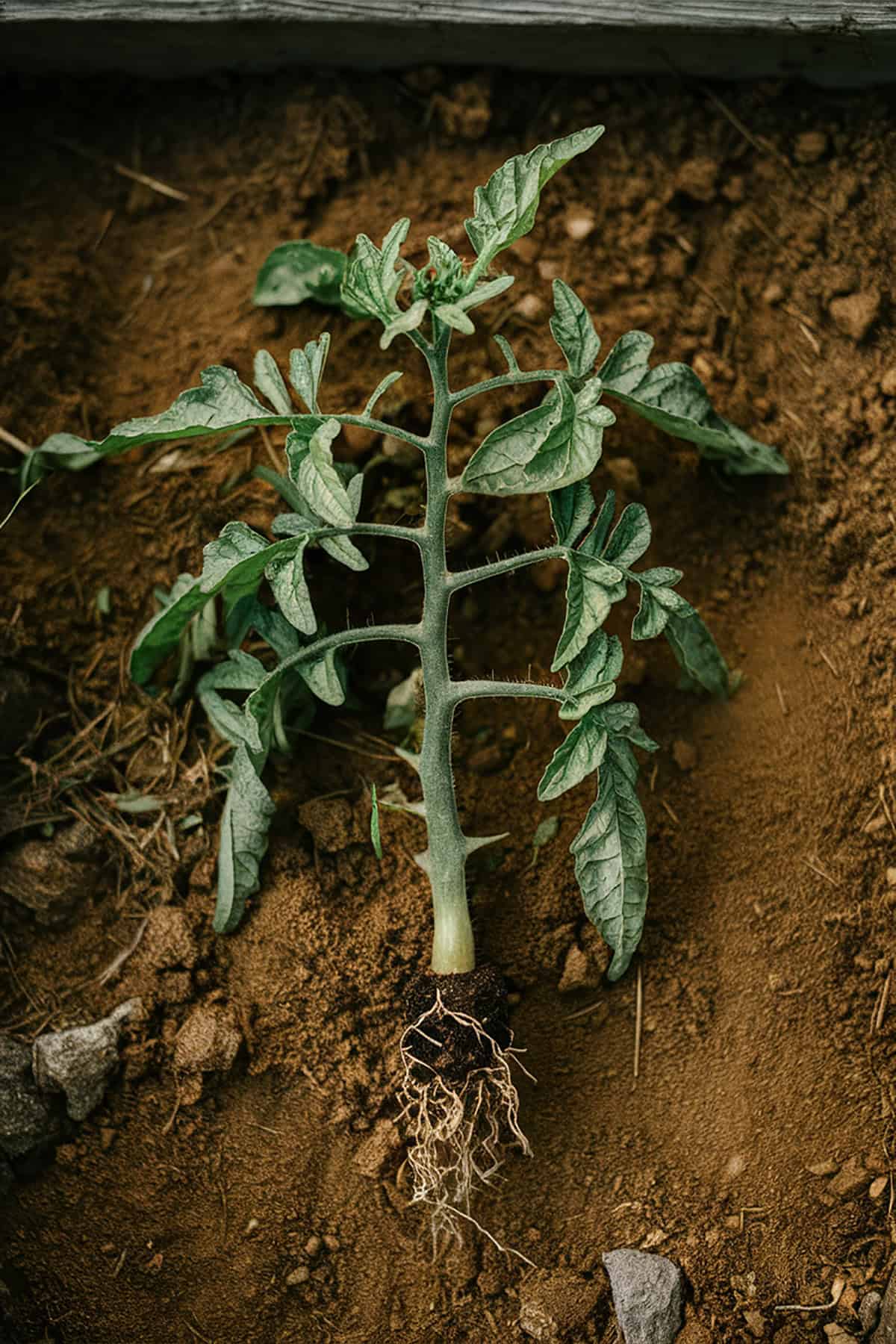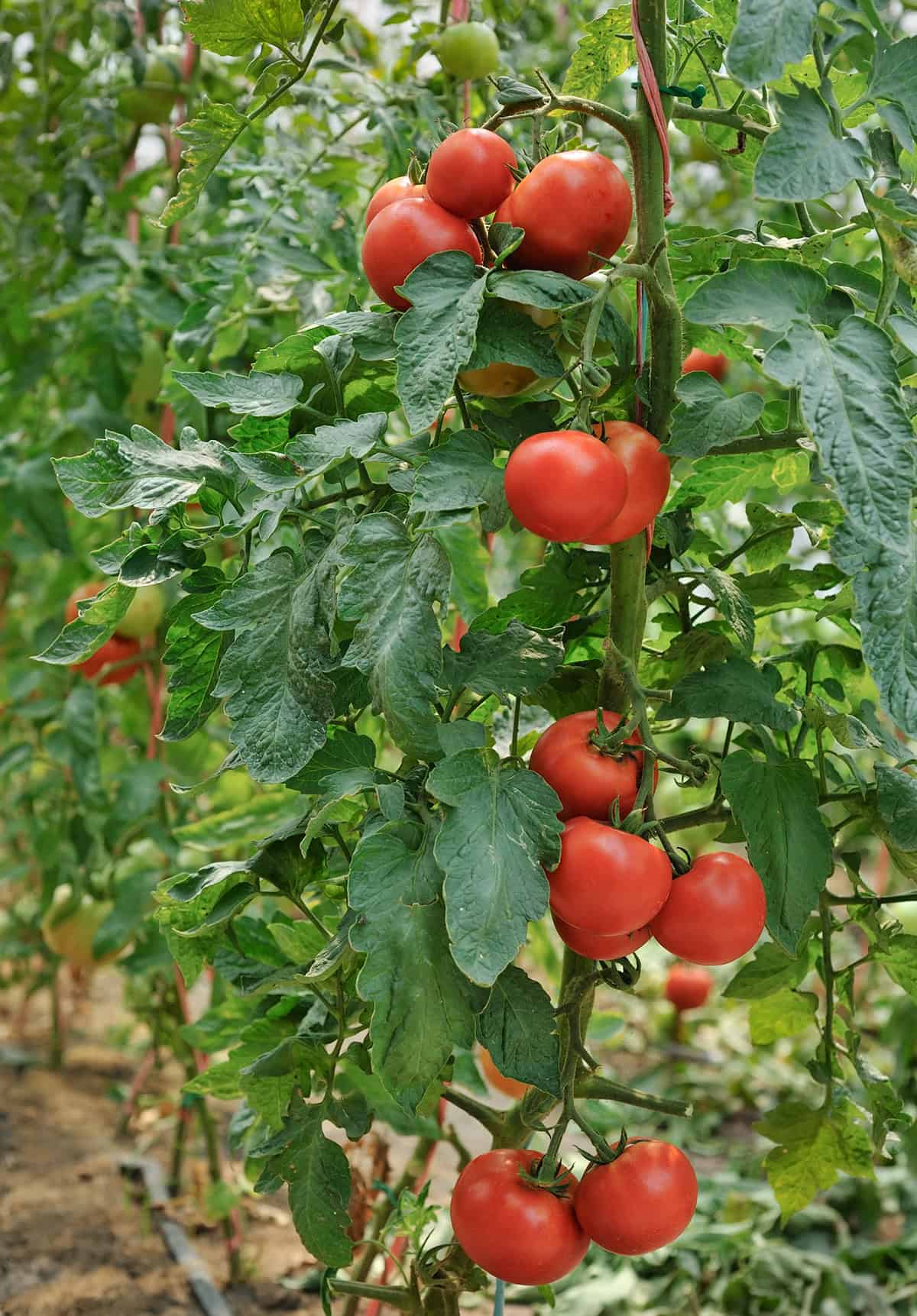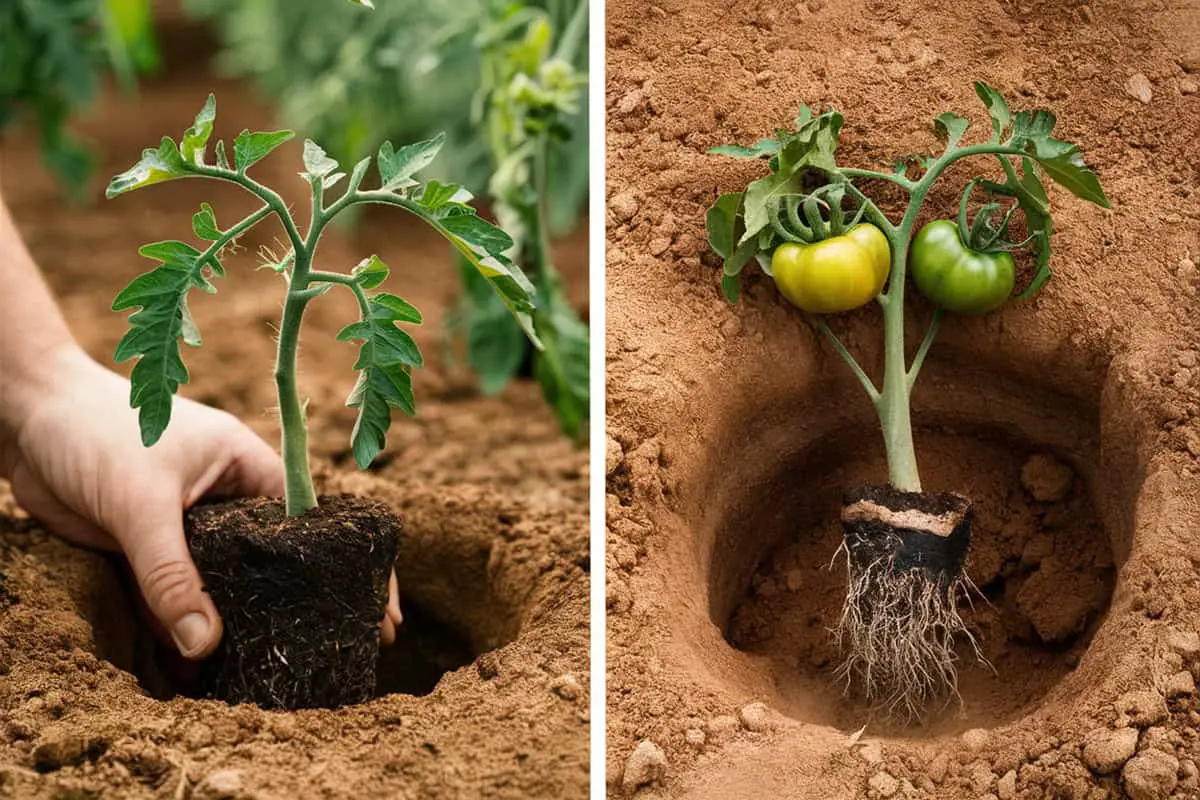You’ve just picked up some tomato seedlings from the local nursery, and you’re eager to get them into the ground. But as you start planting, you wonder if there’s a better way to ensure they thrive. Should you plant them sideways or bury them deeply? Learn the benefits of each method and how to implement them, setting your garden up for a season of abundant, juicy tomatoes.
Table of Contents
Tomato Planting Methods
Plant tomatoes either sideways or bury them deeply. Each method has specific advantages that suit different gardening needs. Both techniques help support robust root systems, which are essential for healthy tomato plants.
Sideways Planting Technique
Sideways planting, also known as trench planting, involves laying the tomato plant horizontally in a trench. This method takes advantage of higher soil temperatures near the surface. You need to dig a trench about 6 inches deep and place the plant in it with only the top leaves exposed.
The plant will then develop roots along the buried stem. This increases root mass and provides better nutrient uptake. The trench method is effective for young plants and cooler soil conditions. Ensure the top of the plant remains uncovered and in direct sunlight for optimal growth.
Deep Planting Technique
Deep planting involves burying a large portion of the tomato stem vertically. You should remove the lower leaves and bury the plant 5-6 inches deep. This technique allows the stem to develop roots along its buried length, enhancing stability and nutrient absorption.
This method is particularly useful in warmer soils. The root structure increases, making the plant more drought-resistant. Deep planting requires a well-prepared hole but ensures a robust, healthy plant capable of producing larger fruits. Ensure the upper leaves are above ground and receive sufficient sunlight for best results.
Benefits of Sideways Planting

Stronger Root System
Sideways planting helps tomato plants develop a stronger root system by allowing the buried stem to produce additional roots.
Enhanced Nutrient Absorption
An increased root system improves nutrient absorption, enabling the plant to access more water and nutrients, leading to healthier and more productive plants.
Prevents Stem Damage
Burying the stem reduces exposure to environmental stressors like wind and pests, minimizing the risk of damage.
Improved Stability
With a larger root system, the plant becomes more resistant to being uprooted by strong winds, enhancing stability.
Optimizes Garden Space
This technique allows better use of horizontal space, which is particularly useful in smaller gardens.
Combats Leggy Seedlings
Sideways planting helps tall, thin seedlings grow stronger by encouraging more root growth along the buried stem.
Efficient Watering
A well-established root system allows for more effective water absorption, reducing waste and improving overall plant health.
Increases Harvest
Healthy plants with robust roots are more likely to produce abundant fruit, leading to a bountiful harvest.
Benefits of Deep Planting

Enhanced Root Development
Step-by-Step Guide to Sideways Planting
Sideways planting, or trench planting, offers an effective way to improve tomato root systems. This method can lead to healthier and more productive plants by utilizing more of the plant’s stem for root development.
Preparing the Plant
Start by selecting strong, healthy tomato seedlings. Choose plants with thick stems and robust leaves. Avoid those that appear wilted or have yellowing leaves.
Water the plants thoroughly for a few hours before transplanting. This helps reduce transplant shock. Prune away the lower leaves, leaving only the top few sets of leaves intact. This step ensures that the buried stem sections will focus on developing roots rather than supporting unnecessary foliage.
Digging the Trench
Use a shovel to dig a trench about 6 inches deep in your garden bed or container. The length of the trench should accommodate the entire length of your plant from the root ball to the top leaves. Ensure the soil is well-draining and amended with compost or organic matter.
Work the soil at the bottom of the trench to loosen it up. Mix in a tablespoon of superphosphate to promote root growth. This nutrient-rich environment encourages quick establishment and vigorous root development. Ensure the trench is level and free from large clods of soil or stones.
Laying the Plant
Place the tomato plant horizontally in the trench. Only the topmost leaves should be above the soil surface. If necessary, slant the plant slightly to align it better with the trench.
Gently cover the stem with soil, pressing down lightly to eliminate air pockets. Water the trench thoroughly, ensuring the soil settles around the stem. The buried stem sections will quickly develop roots, creating a stronger and more resilient plant.
Install support systems like cages or stakes. Adding these supports early helps prevent damage to the roots later on. Ensure the supports are secure and can handle the weight of the mature plant.
Step-by-Step Guide to Deep Planting
Deep planting tomatoes helps the plant develop a robust root system. This method can lead to healthier plants and better yields. Following these steps will ensure your tomato plants thrive.
Preparing the Plant
To begin, select a healthy tomato plant. Remove any lower leaves. This prevents rot and disease. Keeping only a few leaves at the top helps the plant focus on root growth. Trim any flowers or buds too. The aim is to maximize root development.
Next, hydrate the plant well. Water it thoroughly an hour before transplanting. This prevents shock during the transfer. A well-watered plant adapts faster to new soil conditions.
Digging the Hole
Start by choosing a sunny spot with well-draining soil. Dig a hole deep enough to bury two-thirds of the plant. This may be 8 to 12 inches deep, depending on the plant’s size.
Add a tablespoon of superphosphate to the hole. Mix it with the soil at the bottom. This provides essential nutrients to support root development. If your soil is clay-heavy, consider adding some compost or aged manure to improve drainage and fertility.
Burying the Stem
Gently place the tomato plant into the hole. Ensure that only the top few leaves are above the soil surface. This depth allows roots to form along the buried stem.
Firm the soil around the plant. This helps to keep it stable and supports new root growth. Water the plant thoroughly after transplanting. Consistent watering is vital for the first few weeks. This aids the plant in establishing a robust root system.
Comparing Results

Planting tomatoes sideways or deeply can have distinct impacts on growth rates, yield differences, and pest and disease resistance. Each method offers unique benefits that can significantly influence the success of your tomato plants.
Growth Rates
When you plant tomatoes sideways, the buried stem can develop more roots. These additional roots enhance the plant’s access to nutrients and water, which can speed up growth. A well-established root system can result in stronger, healthier plants.
Burying the stem deeply also promotes root growth, but may initially slow plant development. The plant needs time to establish its roots before it can focus on upward growth. This method is beneficial in the long run, as it helps the plant withstand fluctuations in water availability.
Both methods aim to improve root structure, but sideways planting may result in quicker initial growth while burying deeply might offer steadier growth.
Yield Differences
The yield of your tomato plants can vary depending on how you plant them. Sideways planting can lead to higher yields due to the more extensive root system, which supports better nutrient absorption and plant health. This method can also allow for quicker establishment and potentially more flowers and fruits.
Burying the stem deeply generally results in fewer but larger and healthier fruits. The plant’s deep root system contributes to more consistent moisture and nutrient uptake, leading to robust fruit development. You might notice fewer tomatoes, but each one is typically larger and of higher quality.
Both methods can increase yields, but the nature of the fruits produced may differ.
Pest and Disease Resistance
Sideway planting can provide an edge in pest and disease resistance. The extensive root system supports a healthier plant overall, making it more resilient to pests and diseases. The plant’s increased vigor helps it better withstand attacks and recover from infestations or infections.
When you bury the stem deeply, the plant benefits from improved stability and anchorage, reducing stress and potential damage from high winds. A healthy root system can also improve the plant’s immune response to pathogens.
Best Practices and Tips
For the best results when planting tomatoes, focus on soil preparation, proper watering, and mulching. These key practices will ensure healthy growth and abundant harvests.
Soil Preparation
Tomatoes thrive in nutrient-rich, well-drained soil. Start by loosening the soil to a depth of at least 12 inches. This ensures the roots have ample space to grow.
Mix in organic matter like compost or aged manure to boost soil fertility. Aim for a slightly acidic pH of 6.0 to 6.8 for optimal growth. If your soil is too alkaline, you might need to add some sulfur. For areas with heavy clay, consider raised beds to improve drainage.
Watering Techniques
Consistent watering is crucial for tomatoes. Water deeply to reach the root zone, but avoid wetting the leaves to prevent diseases.
It’s best to water in the morning to allow the foliage to dry during the day. Invest in a drip irrigation system for efficient watering. Mulching can help retain moisture.
Adjust the watering frequency based on weather and soil type. Sandy soils need more frequent watering than clay soils. A general rule is to provide 1-1.5 inches of water per week.
Mulching Recommendations
Mulching helps maintain moisture, regulate soil temperature, and prevent weeds. Use organic mulches like straw, grass clippings, or shredded leaves. Apply a 2-3 inch layer around the base of the tomato plants, but keep it a few inches away from the stem to prevent rot. Mulching also reduces soil erosion and nutrient loss. Replace mulch as it decomposes to maintain its effectiveness. In cooler climates, black plastic mulch can provide an added boost in soil warmth.




